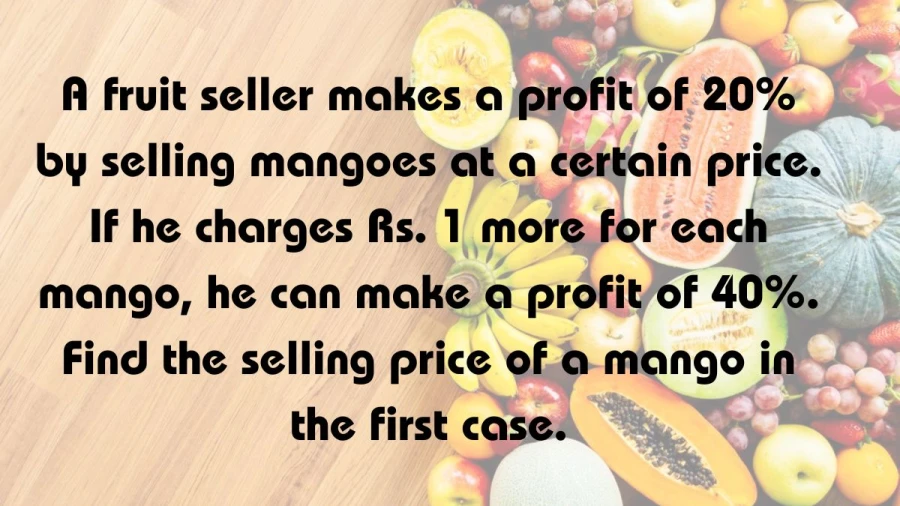If you happen to be viewing the article A fruit seller makes a profit of 20% by selling mangoes at a certain price. If he charges Rs. 1 more for each mango, he can make a profit of 40%. Find the selling price of a mango in the first case. ? on the website Math Hello Kitty, there are a couple of convenient ways for you to navigate through the content. You have the option to simply scroll down and leisurely read each section at your own pace. Alternatively, if you’re in a rush or looking for specific information, you can swiftly click on the table of contents provided. This will instantly direct you to the exact section that contains the information you need most urgently.
A fruit seller makes a profit of 20% by selling mangoes at a certain price. If he charges Rs. 1 more for each mango, he can make a profit of 40%. Find the selling price of a mango in the first case.
The selling price of a mango in the first case is Rs. 6.
-
In the first case, the profit is 20%, so the selling price is 120% of the cost price: S1 = C + 0.20C = 1.20C
-
In the second case, when the mangoes are sold for Rs. 1 more each, the selling price becomes S1 + 1 and the profit becomes 40%, so: S1 + 1 = C + 0.40C = 1.40C
We have two equations now:
- S1 = 1.20C
- S1 + 1 = 1.40C
Let’s solve these equations simultaneously to find S1 and C.
Substituting the value of S1 from the first equation into the second equation:
Subtracting 1.20C from both sides:
- 1 = 1.40C – 1.20C
- 1 = 0.20C
Dividing both sides by 0.20:
Now, we have found the cost price C, to find the selling price in the first case S1, we use the first equation:
- S1 = 1.20C = 1.20 * 5 = Rs. 6
So, the selling price of a mango in the first case is Rs. 6.
Cost Price and Selling Price
Cost Price (CP) and Selling Price (SP) are terminologies used in business and commerce to describe the financial aspects of selling goods or services.
Article continues below advertisement
Article continues below advertisement
-
Cost Price (CP): This is the price at which an item is purchased or manufactured. It includes the cost of materials, labor, overheads, and any other expenses incurred in the production or procurement of the item.
-
Selling Price (SP): This is the price at which an item is sold to the customer. It is the amount for which the goods or services are exchanged in the market. It includes the cost price along with the desired profit margin.
The relationship between CP and SP is crucial in determining profitability. Ideally, the selling price should be higher than the cost price to ensure a profit. The difference between the selling price and the cost price is the profit if SP > CP, or the loss if SP < CP.
Mathematically, you can express the relationship between CP, SP, and profit (P) or loss (L) as follows:
-
If SP > CP:
-
If SP < CP:
It’s important for businesses to carefully calculate their cost prices and set their selling prices in a way that ensures profitability while remaining competitive in the market. Various factors such as demand, competition, production costs, and market trends influence the determination of selling prices.
Thank you so much for taking the time to read the article titled A fruit seller makes a profit of 20% by selling mangoes at a certain price. If he charges Rs. 1 more for each mango, he can make a profit of 40%. Find the selling price of a mango in the first case. written by Math Hello Kitty. Your support means a lot to us! We are glad that you found this article useful. If you have any feedback or thoughts, we would love to hear from you. Don’t forget to leave a comment and review on our website to help introduce it to others. Once again, we sincerely appreciate your support and thank you for being a valued reader!
Source: Math Hello Kitty
Categories: Math

